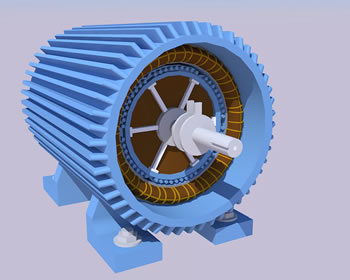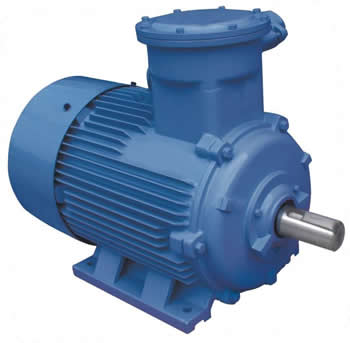Difference between Synchronous and Induction Motor
Key Difference: Synchronous motors and induction motors are the most widely used types of AC motor. In a synchronous electric motor, the rotation of the shaft is synchronized with the frequency of the supply current. An Induction Motor is an AC electric motor in which the electric current in the rotor is produced by electromagnetic induction from the magnetic field of the stator winding.
 Synchronous and Induction Motors are two difference types of AC electric motors. AC electric motors are an electric motor driven by an alternating current (AC). The AC motor commonly consists of two basic parts: an outside stationary stator and an inside rotor. Synchronous motors and induction motors are the most widely used types of AC motor.
Synchronous and Induction Motors are two difference types of AC electric motors. AC electric motors are an electric motor driven by an alternating current (AC). The AC motor commonly consists of two basic parts: an outside stationary stator and an inside rotor. Synchronous motors and induction motors are the most widely used types of AC motor.
The outside stationary stator has coils that are supplied with alternating current. This then produces a rotating magnetic field. The inside rotor is attached to the output shaft which produces a second rotating magnetic field. The rotor magnetic field may be produced by permanent magnets, reluctance saliency, or DC or AC electrical windings.
In a synchronous electric motor, the rotation of the shaft is synchronized with the frequency of the supply current. The rotation period is exactly equal to an integral number of AC cycles. Synchronous motors contain multiphase AC electromagnets on the stator of the motor. These electromagnets create a magnetic field which rotates in time with the oscillations of the line current. On the other hand, the rotor with permanent magnets or electromagnets turns in accordance with the stator field at the same rate. This provides the second synchronized rotating magnet field.
An Induction Motor is an AC electric motor in which the electric current in the rotor is produced by electromagnetic induction from the magnetic field of the stator winding. An induction motor is also known as an asynchronous motor. The rotor in an induction motor can be either wound or a squirrel-cage type.
 Unlike large synchronous motors, an induction motor does not require mechanical commutation, separate-excitation or self-excitation for the energy transferred from stator to rotor.
Unlike large synchronous motors, an induction motor does not require mechanical commutation, separate-excitation or self-excitation for the energy transferred from stator to rotor.
The main difference between Synchronous and Induction Motors is that the synchronous motor rotates in exact synchrony with the line frequency. Additionally, the synchronous motor does not rely on current induction to produce the rotor's magnetic field. The induction motor, on the other hand, requires "slip" to induce current in the rotor winding, which means that the rotor must rotate slightly slower than the AC current alternations.
Comparison between Synchronous and Induction Motor:
|
|
Synchronous Motor |
Induction Motor |
|
Description |
A synchronous electric motor is an AC motor in which, at steady state, the rotation of the shaft is synchronized with the frequency of the supply current. |
An induction or asynchronous motor is an AC electric motor in which the electric current in the rotor needed to produce torque is obtained by electromagnetic induction from the magnetic field of the stator winding. |
|
Contain |
Multiphase AC electromagnets on the stator of the motor |
|
|
Synchronous speed |
Operate at RPM=120f/p |
Operate at less than synchronous speed (RPM=120f/p – slip) |
|
DC excitation |
Synchronous motors require DC excitation to be supplied to the rotor windings |
Induction motors don’t require DC excitation to be supplied to the rotor windings |
|
DC power source |
Synchronous motors require a DC power source for the rotor excitation. |
Induction motors don’t require a DC power source for the rotor excitation. |
|
Rotor excitation |
Synchronous motors require slip rings and brushes to supply rotor excitation. |
Induction motors don’t require slip rings, but some induction motors have them for soft starting or speed control. |
|
Rotor windings |
Synchronous motors require rotor windings |
Induction motors are most often constructed with conduction bars in the rotor that are shorted together at the ends to form a “squirrel cage.” |
|
Starting mechanism |
Synchronous motors require a starting mechanism in addition to the mode of operation that is in effect once they reach synchronous speed. |
Three phase induction motors can start by simply applying power, but single phase motors require an additional starting circuit. |
|
Power factor |
The power factor of a synchronous motor can be adjusted to be lagging, unity or leading |
Induction motors must always operate with a lagging power factor. |
|
Efficiency |
Synchronous motors are generally more efficient than induction motors. |
Induction motors are generally less efficient than synchronous motors. |
|
Slip |
Synchronous motors can be constructed with permanent magnets in the rotor eliminating the slip rings, rotor windings, DC excitation system and power factor adjustability. |
Induction motors contains slip. |
|
Size |
Synchronous motors are usually built only is sizes larger than about 1000 Hp (750 kW) because of their cost and complexity. However, permanent magnet synchronous motors and electronically controlled permanent synchronous motors called brushless DC motors are available in smaller sizes. |
Smaller induction motors are built and commonly in household applications. |
|
Used in |
Timing applications such as in synchronous clocks, timers in appliances, tape recorders and precision servomechanisms |
Three-phase squirrel-cage induction motors are widely used in industrial drives because they are rugged, reliable and economical. Single-phase induction motors are used extensively for smaller loads, such as household appliances like fans. |
Image Courtesy: mark5150.deviantart.com, dongye-cn.en.made-in-china.com









Add new comment